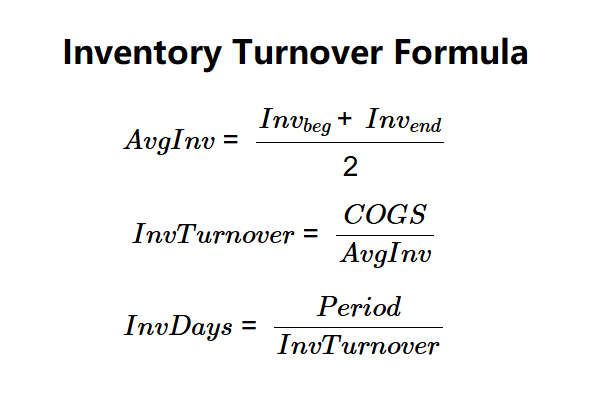1. What is the Inventory Turnover and Related Metrics Calculator?
Definition: This calculator computes the average inventory (\( AvgInv \)), inventory turnover (\( InvTurnover \)), and inventory days (\( InvDays \)), which measure how efficiently a company manages its inventory over a user-defined period.
Purpose: Helps businesses assess inventory efficiency, optimize stock levels, and improve cash flow by analyzing turnover rates and days on hand based on a customizable period.
2. How Does the Calculator Work?
The calculator follows a three-step process to compute inventory metrics using a user-specified period:
Formulas:
$$ AvgInv = \frac{Inv_{beg} + Inv_{end}}{2} $$
$$ InvTurnover = \frac{COGS}{AvgInv} $$
$$ InvDays = \frac{Period}{InvTurnover} $$
Where:
- \( AvgInv \): Average Inventory (dollars)
- \( Inv_{beg} \): Beginning Inventory (dollars)
- \( Inv_{end} \): Ending Inventory (dollars)
- \( COGS \): Cost of Goods Sold (dollars)
- \( InvTurnover \): Inventory Turnover (times)
- \( InvDays \): Inventory Days (days)
- \( Period \): Length of the period (days)
Steps:
- Step 1: Determine \( Inv_{beg} \) and \( Inv_{end} \). Input the inventory values at the beginning and end of the period.
- Step 2: Calculate \( AvgInv \). Average the beginning and ending inventory.
- Step 3: Determine \( COGS \). Input the cost of goods sold for the period.
- Step 4: Determine \( Period \). Input the length of the period in days.
- Step 5: Calculate \( InvTurnover \). Divide \( COGS \) by \( AvgInv \).
- Step 6: Calculate \( InvDays \). Divide \( Period \) by \( InvTurnover \).
3. Importance of Inventory Turnover Calculation
Calculating inventory turnover and days is crucial for:
- Inventory Management: A higher \( InvTurnover \) indicates efficient stock use, while \( InvDays \) shows how long inventory is held.
- Financial Efficiency: Helps optimize inventory to reduce holding costs and improve liquidity.
- Performance Benchmarking: Allows comparison with industry standards based on the chosen period.
4. Using the Calculator
Example 1:
\( COGS = \$50,000 \), \( Inv_{beg} = \$10,000 \), \( Inv_{end} = \$12,000 \), \( Period = 365 \) days:
- Step 1: \( Inv_{beg} = \$10,000 \), \( Inv_{end} = \$12,000 \).
- Step 2: \( AvgInv = \frac{10,000 + 12,000}{2} = \$11,000 \).
- Step 3: \( COGS = \$50,000 \).
- Step 4: \( Period = 365 \) days.
- Step 5: \( InvTurnover = \frac{50,000}{11,000} \approx 4.55 \).
- Step 6: \( InvDays = \frac{365}{4.55} \approx 80.22 \) days.
- Results: \( AvgInv = \$11,000 \), \( InvTurnover = 4.55 \), \( InvDays = 80.22 \) days.
An inventory turnover of 4.55 and 80.22 days suggest moderate efficiency over a year.
Example 2:
\( COGS = \$60,000 \), \( Inv_{beg} = \$20,000 \), \( Inv_{end} = \$15,000 \), \( Period = 90 \) days:
- Step 1: \( Inv_{beg} = \$20,000 \), \( Inv_{end} = \$15,000 \).
- Step 2: \( AvgInv = \frac{20,000 + 15,000}{2} = \$17,500 \).
- Step 3: \( COGS = \$60,000 \).
- Step 4: \( Period = 90 \) days.
- Step 5: \( InvTurnover = \frac{60,000}{17,500} \approx 3.43 \).
- Step 6: \( InvDays = \frac{90}{3.43} \approx 26.24 \) days.
- Results: \( AvgInv = \$17,500 \), \( InvTurnover = 3.43 \), \( InvDays = 26.24 \) days.
An inventory turnover of 3.43 and 26.24 days indicate efficient quarterly turnover.
Example 3:
\( COGS = \$30,000 \), \( Inv_{beg} = \$5,000 \), \( Inv_{end} = \$7,000 \), \( Period = 180 \) days:
- Step 1: \( Inv_{beg} = \$5,000 \), \( Inv_{end} = \$7,000 \).
- Step 2: \( AvgInv = \frac{5,000 + 7,000}{2} = \$6,000 \).
- Step 3: \( COGS = \$30,000 \).
- Step 4: \( Period = 180 \) days.
- Step 5: \( InvTurnover = \frac{30,000}{6,000} = 5.00 \).
- Step 6: \( InvDays = \frac{180}{5.00} = 36.00 \) days.
- Results: \( AvgInv = \$6,000 \), \( InvTurnover = 5.00 \), \( InvDays = 36.00 \) days.
An inventory turnover of 5.00 and 36.00 days reflect efficient inventory management over six months.
5. Frequently Asked Questions (FAQ)
Q: What is inventory turnover?
A: Inventory turnover (\( InvTurnover \)) measures how many times a company's inventory is sold and replaced over a period.
Q: What does inventory days represent?
A: Inventory days (\( InvDays \)) indicate the average number of days it takes to sell the entire inventory, based on the specified period.
Q: Can inventory turnover be zero?
A: No, a zero or negative turnover would indicate an error, as it requires positive COGS and average inventory.
Inventory Turnover and Related Metrics Calculator© - All Rights Reserved 2025
 Home
Home
 Back
Back
